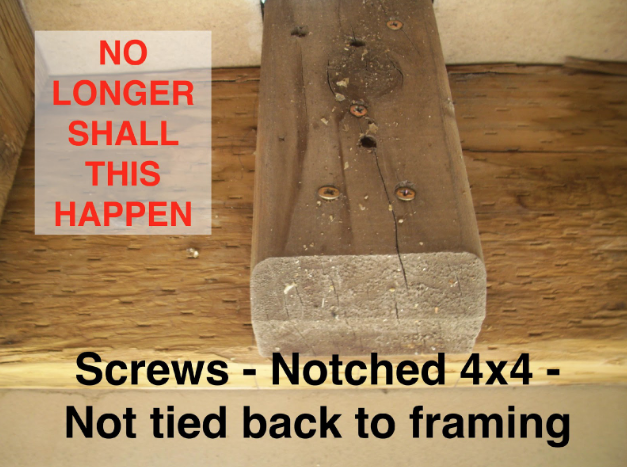August 29th, 2019
By: Glenn Mathewson
The latest 2018 edition of the International Residential Code provides a complete package of prescriptive structural design tables for decks… sort of… When we think of structural design, most people imagine the skeleton of ledgers, joists, beams, and posts. At this completion, one might be ready for a “rough frame” inspection. Install the decking and you’ve got a system that will hold people up, but it won’t keep them up. There’s a critical structural component of elevated decks that’s missing.
Guards.
Guards are barriers required at the edges of raised floors that help keep us from falling off. They can be rails, cables or pipes. They can be wood, metal, vinyl, or glass. They can be benches, planter boxes, outdoor kitchens, or privacy walls. Architecturally, they can be practically anything that meets the minimum height, maximum openings, and minimum structural capacity. Indeed, guards are part of the deck structure. Table 301.5 requires a live load resistance of 200 lbs. in any direction along the top of the guard, but stops there. There is no guidance in the code for how to achieve this.
NADRA supported a proposal with others in the Deck Code Coalition to change that. After many meetings with discussions ranging from a complete detail of guard construction to not adding anything, compromise (which is not a negative thing) and shared perspectives led us to common ground. The proposal would prohibit a few notorious problems and provide some general language about the load path. This would be a good start. This is proposal RB185-19, and it was approved at the IRC Committee Action Hearing this March. Here is a brief, bulleted summary of what it includes.
- Guard posts must be connected into the deck framing, not just the outer joist or beam, where such member can rotate under load.
- Guard posts cannot be fastened only into the end-grain of lumber.
- Guard posts mounted on top of the deck (surface mounted) must be done according the manufacturer installation instruction and must connect to the deck framing or blocking.
- Wood 4×4 guard posts cannot be notched at the point of connection.
While this will reduce the most egregious guard connections and make a big impact on safety, it still doesn’t provide any assurance of any guard construction capability. That’s what proposal RB301-19 provides.
With such variety of guard design, it’s difficult to specify one method, and it risks all other designs being considered “noncompliant”. Something common, however, to many guards is a wood post. This second guard proposal provides a handful of engineered methods to attach a guard post to wood deck framing that will meet the loads required by the IRC. Methods using hardware and methods using only commodity fasteners are provided for design flexibility. These details are proposed for a new appendix chapter in the IRC, so they are not misunderstood as a strict requirement. Appendix chapters are optional unless adopted as mandatory by a government. They provide guidance, and that is exactly the intent of the appendix we have proposed. This proposal was not approved at the first hearing, but we received good feedback as to why. NADRA and the DCC members got back together and kept at it. We submitted a public comment in hopes of earning the ICC governmental membership approval this October at the Final Action Hearings.
Please support RB185-19 and RB301-19 and help us develop quality minimum standards for safe deck design and construction, while balancing affordability and freedom.




